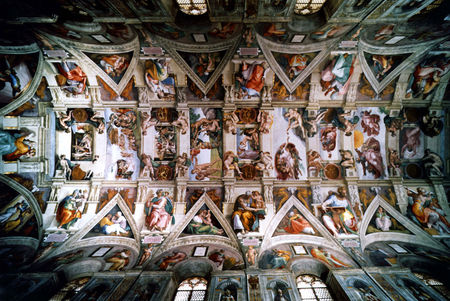Expert Says Michelangelo Drew Inspiration from Brothels to Paint Frescoes in Sistine Chapel
The ceiling of the Sistine Chapel in the Vatican City. AP Photo
ROME.- The Renaissance genius artist Michelangelo Buonarroti drew inspiration from various Italian brothels to paint some of the figures that form part of the frescoed panels of the Sistine Chapel, assured specialist Elena Lazzarini in an article published today in “Corriere della Sera”.
One of the frescoed panels of the Sistine Chapel was inspired by brothels according to the expert. Italian renaissance artists frequently went to what’s called “stufa”, public bathrooms similar to a brothel where prostitution was practiced often, to study models that would later be represented in their work.
One fountain of inspiration present in the production of many artists of this era, from Leonardo to Bronzino, down to Michelangelo. According to Lazzarini, Many of the blessed and condemned that make up part of the frescoed panels of the Sistine Chapel are shown in obscene situations.
A condemned is dragged to hell by the testicles
“A condemned, for example, is dragged to hell by the testicles and between the blessed they would produce ambiguous hugs and kisses, clearly of homosexual nature”, explains the specialist.
Lazzarini adds “The male bodies, very virile, that make up the painting of the Final Judgment corresponds to the physical appearance of farmers and carriers shown during labor, with tense muscles, tiredness and effort reflected on their faces.”
The impotent scene of the Final Judgment, measuring 3.7 by 12.2 meters, was painted by Michelangelo between 1536 and 1541 to decorate the wall that was located near the Chapel altar.
According to the Italian specialist, it was in the public bathrooms in the Italian capital where Michelangelo was inspired to decorate the Vatican jewels.
Promiscuous Places
There were many places during the XVI century in Italy and particularly in Rome, Lazzarini explains, and in them, besides doing beauty treatments and hydrotherapy, “there were stations with more separation, places of promiscuity and male and female prostitution.” References found in other work of renaissance artist like Leonardo or Bronzino, according to the specialist. “It was a very common opinion at that era to consider that physiognomy corresponded to an emotional and physical ideal. And these models weren’t just Michelangelo´s, we found they started from Leonardo in various works and they are also present in the work of Bronzino”, added Lazzarini.

/https%3A%2F%2Fprofilepics.canalblog.com%2Fprofilepics%2F1%2F0%2F100183.jpg)
/https%3A%2F%2Fstorage.canalblog.com%2F03%2F02%2F119589%2F96711876_o.jpg)
/https%3A%2F%2Fstorage.canalblog.com%2F11%2F31%2F119589%2F94773502_o.jpg)
/https%3A%2F%2Fstorage.canalblog.com%2F20%2F83%2F119589%2F94772815_o.jpg)
/https%3A%2F%2Fstorage.canalblog.com%2F26%2F72%2F119589%2F75604929_o.jpg)
/https%3A%2F%2Fstorage.canalblog.com%2F59%2F60%2F119589%2F26458628_o.jpg)



/http%3A%2F%2Fstorage.canalblog.com%2F18%2F85%2F119589%2F126075574_o.jpg)
/http%3A%2F%2Fstorage.canalblog.com%2F19%2F64%2F119589%2F121786201_o.jpg)
/http%3A%2F%2Fstorage.canalblog.com%2F29%2F43%2F119589%2F118144989_o.jpg)
/http%3A%2F%2Fstorage.canalblog.com%2F33%2F86%2F119589%2F111966761_o.jpg)